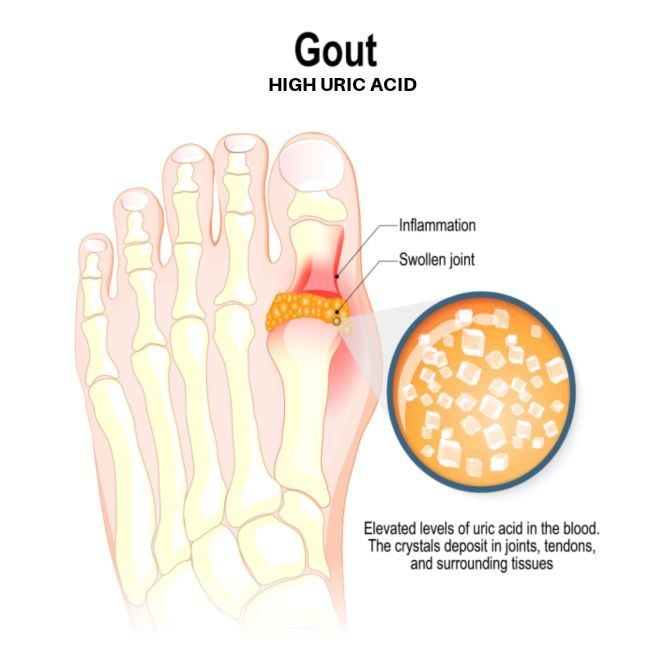What You Should Know to Prevent Gout - Uric Acid Test

Table of Contents
What is Uric Acid?
Uric acid is a byproduct of the body breaking down purines (compounds that provide essential building blocks for synthesizing DNA and RNA) in food. After the purines are broken down, uric acid travels to the kidneys through the bloodstream, where it is filtered and expelled from the body via urination. High uric acid levels in one's blood could be an indicator or cause of more serious health conditions like gout.
Why Should I Monitor My Uric Acid Levels?
A high concentration of uric acid is called hyperuricemia. This blood test value indicates that the body is either producing too much uric acid while breaking down purines or that the kidneys cannot properly filter the correct amount of uric acid out of the body. You may undergo a Uric Acid (Serum) test before or after certain types of chemotherapy, as rapid destruction of cancerous cells or significant weight loss can increase uric acid levels in the bloodstream. High uric acid levels can lead to gout, a painful form of arthritis characterized by uric acid crystallizing in the joints, skin, and other tissues. This crystallization process can also lead to the formation and deposition of kidney stones.
An unusually low uric acid level is called hypouricemia. While it is typically asymptomatic, affected individuals might be at greater risk of acute kidney injury. Deficiencies in zinc, iron, or molybdenum can result in hypouricemia. Molybdenum cofactor deficiency is a serious medical condition characterized by declining brain function. Molybdenum plays a critical role in purine degradation, so a deficiency can significantly reduce the amount of uric acid the body can produce.
What Drives Uric Acid Formation?
There are many potential causes of higher-than-normal levels of uric acid. Diet can be a huge factor in the development of uric acid if one consumes too many purine-rich foods and beverages. A major driver of uric acid excess is high levels of fructose consumption. Levels of sugar consumption across the globe have dramatically increased over the past century, in tandem with rates of obesity and diabetes. Individuals with diabetes may develop high uric acid levels if their bodies cannot produce enough insulin. Since insulin is used to help sugars enter the body's cells, the inability to process that sugar can lead to a buildup of uric acid and many other serious health complications. Intaking too much high-fructose corn syrup or table sugar, even in non-diabetic individuals, can result in elevated uric acid levels in the bloodstream. However, sugary sweets are not the only possible culprit. Many foods, such as liver, game meat, certain seafood, gravy, dried beans, and peas, contain a high concentration of purines, rendering them able to function as a driver in the formation of excess uric acid. Other potential causes could be high alcohol consumption, chemotherapy-related side effects, rapid weight loss, psoriasis, or even certain prescription medications. Finally, high uric acid can result from renal failure when the kidneys do not function properly and excretion is reduced.
What To Know About the Uric Acid Serum Test
A Uric Acid (Serum) test measures the concentration of uric acid in the liquid part of the blood, otherwise known as the serum. Alternative tests can measure the amount of uric acid in one's urine. Your healthcare provider will provide specific instructions regarding any preparation requirements for the test, including whether fasting is necessary and for how long. Additionally, certain medications can impact test results, so a health care provider will be sure to inform their patient what medicines they should and should not take before testing. A healthy range of uric acid in the blood is between 3.5 and 7.2 milligrams per deciliter (mg/dL). While potential first steps to lowering excessive uric acid levels are reducing sugar and urine intake and exercising regularly, treatments are available for individuals who cannot bring down uric acid concentration through lifestyle choices alone. Allopurinol and febuxostat are two medications that help reduce the body's production of uric acid. There are also drugs such as probenecid designed to help improve kidney efficiency in expelling uric acid from the body. Monitoring your uric acid concentration is imperative in preventing gout and/or kidney stones. For an accurate and affordable measurement of uric acid levels, consider ordering a Uric Acid (Serum) test from discountedlabs.com. Seek testing or medical attention if you are experiencing hyperuricemia symptoms such as joint pain, swelling, or redness, as these could be indicators of gout attacks.
References
-
Bardin, T., & Richette, P. (2014):
-
Choi, H. K., Liu, S., & Curhan, G. (2005):
-
Drum, D. E., Goldman, P. A., & Jankowski, C. B. (1981):
-
Hahn K, Kanbay M, Lanaspa MA, Johnson RJ, Ejaz AA (2017):
-
Johnson, R. J., Nakagawa, T., Sanchez-Lozada, L. G., Shafiu, M., Sundaram, S., Le, M., … & Lanaspa, M. A. (2013):









